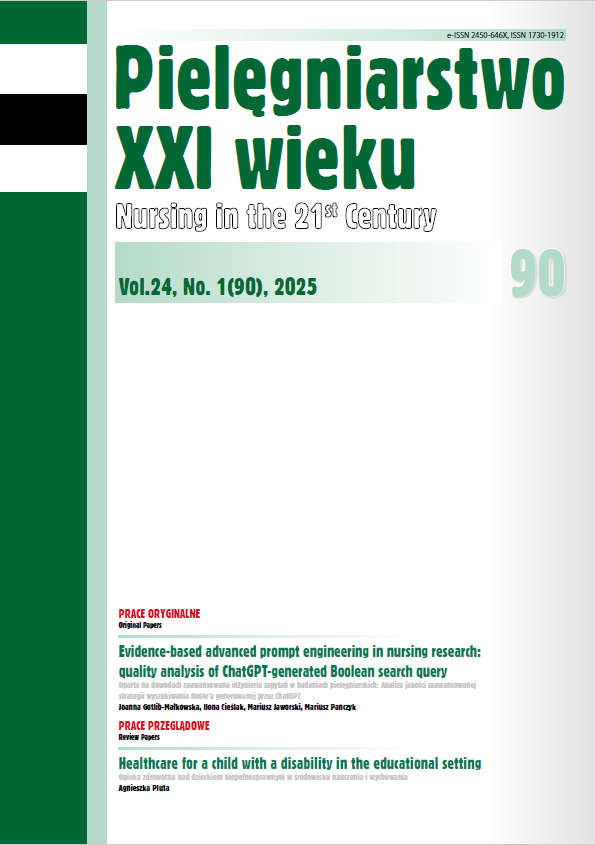Nurses’ knowledge about sepsis: development and psychometric testing of a new instrument
DOI:
https://doi.org/10.12923/pielxxiw-2025-0003Keywords:
sepsis, epidemiology, instrument development, clinical education, infectious diseases nursingAbstract
NURSES’ KNOWLEDGE ABOUT SEPSIS: DEVELOPMENT AND PSYCHOMETRIC TESTING OF A NEW INSTRUMENT
Aim. The aim of the study was to develop and psychometrically test nurses’ knowledge about Sepsis Scale.
Material and methods. A 7-step approach, including item generation, content adequacy assessment, questionnaire administration, factor analysis, internal consistency assessment, construct validity, and replication was used to identify and validate the scale. Validation was carried out among a convenience sample of 265 participants over a period of three years.
Results. Exploratory factor analysis showed that a three-factor structure best fit the data. The reliability of the two factors based on the Kuder–Richardson Formula 20 was for the knowledge factor 0.702, for the proceedings factor was a score of 0.631. For the attitude factor Cronbach’s Alpha was 0.884.
Conclusions. Having an appropriate tool to test knowledge levels is crucial for determining the number of cases and deaths due to sepsis; thus, creating a tool consisting of knowledge research is the best way to assess nurses’ general knowledge about sepsis. The instrument will be useful for nurses and healthcare managers for assessing their knowledge of sepsis, monitoring changes in knowledge throughout professional development, and evaluating both the need for and effectiveness of training programs.
References
1. Genga KR, Russell JA. Update of sepsis in the intensive care unit. Journal of innate immunity. 2017; 9(5): 441-455.
2. Reinhart LDR, Kissoon N, Machado FR, et al. Recognizing Sepsis as a Global Health Priority - a WHO resolution. The New England Journal of Medicine; 2017; 377(5): 414-417.
3. Singer M, Deutschman CS, Seymour CW, et al. The third international consensus definitions for sepsis and septic shock (Sepsis-3). JAMA. 2016; 315(8): 801-810.
4. Makic MBF, Bridges E. Managing Sepsis and Septic Shock Current Guidelines and Definitions. AJN The American Journal of Nursing. 2018; 118(2): 34-39.
5. Torsvik M, Gustad LT, Mehl A, et al. Early identification of sepsis in hospital inpatients by ward nurses increases 30-day survival. Critical Care. 2016; 20(1): 244.
6. Branco MJC, Lucas APM, Marques RMD, et al. The role of the nurse in caring for the critical patient with sepsis. Rev. Bras. Enferm. 2020; 73(4): e20190031.
7. Horvat L, Fry M, Fong J, et al. To explore the nursing assessment and initial management of septic patients in the emergency department. Australasian Emergency Nursing Journal. 2011; 14: S17.
8. Jeffery AD, Mutsch KS, Knapp L. Knowledge and recognition of SIRS and sepsis among pediatric nurses. Pediatric nursing. 2014; 40(6): 271-278.
9. Storozuk SA, MacLeod ML, Freeman S, et al. A survey of sepsis knowledge among Canadian emergency department registered nurses. Australasian emergency care. 2019; 22(2): 119-125.
10. Van den Hengel L, Visseren T, Meima-Cramer P, et al. Knowledge about systemic inflammatory response syndrome and sepsis: a survey among Dutch emergency department nurses. International Journal of Emergency Medicine. 2016; 9(1): 19.
11. Stamataki P, Papazafiropoulou A, Kalaitzi S, et. al. Knowledge regarding assessment of sepsis among Greek nurses. Journal of Infection Prevention. 2014; 15(2): 58-63.
12. Horak J, Martinkova V, Radej J, et al. Back to Basics: Recognition of Sepsis with New Definition. J. Clin. Med. 2019; 8(11): 1838.
13. Hinkin TR, Tracey JB, Enz CA. Scale construction: Developing reliable and valid measurement instruments. Journal of Hospitality & Tourism Research. 1997; 21(1): 100-120.
14. Coiner SE, Wingo NP. Addressing Gaps in Nurses’ Knowledge of Sepsis: A Literature Review. The Journal of Continuing Education in Nursing. 2021; 52(1): 43-46.
15. Nucera G, Esposito A, Tagliani N, et al. Physicians’ and nurses’ knowledge and attitudes in management of sepsis: An Italian study. J. Health Soc. Sci. 2018; 3(1): 13-26.
16. Robson W, Beavis S, Spittle N. An audit of ward nurses’ knowledge of sepsis. Nursing in Critical Care. 2007; 12(2): 86-92.
17. Nunnally JC. Psychometric theory - 25 years ago and now. Educational Researcher. 1975; 4(10); 7-21.
18. Taber KS. The use of Cronbach’s alpha when developing and reporting research instruments in science education. Research in Science Education. 2018; 48(6): 1273-1296.
19. Norman DA, Sandvik LV, Fjortof H. Reduced grading in assessment: A scoping review. Teaching and Teacher Education. 2023; 135: 104336.
Downloads
Published
Issue
Section
License
Copyright (c) 2025 Authors

This work is licensed under a Creative Commons Attribution 4.0 International License.




